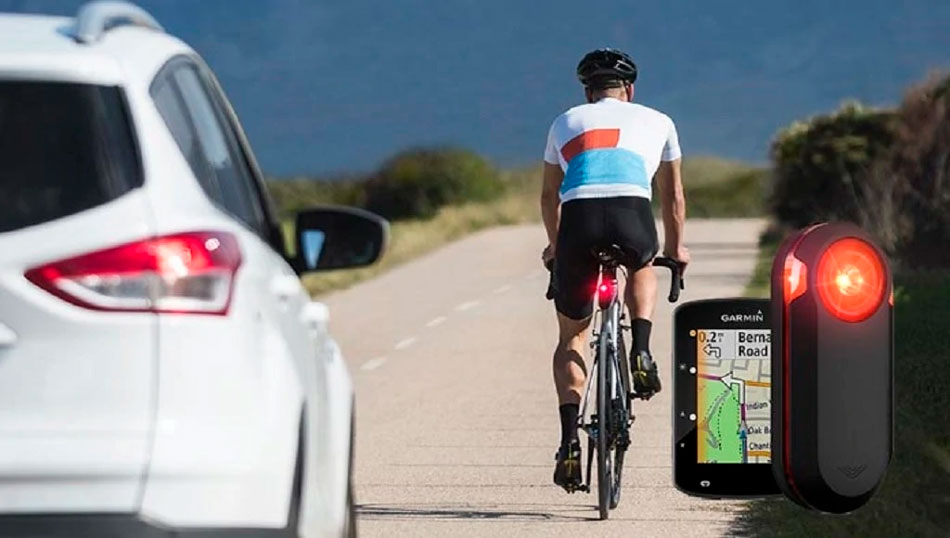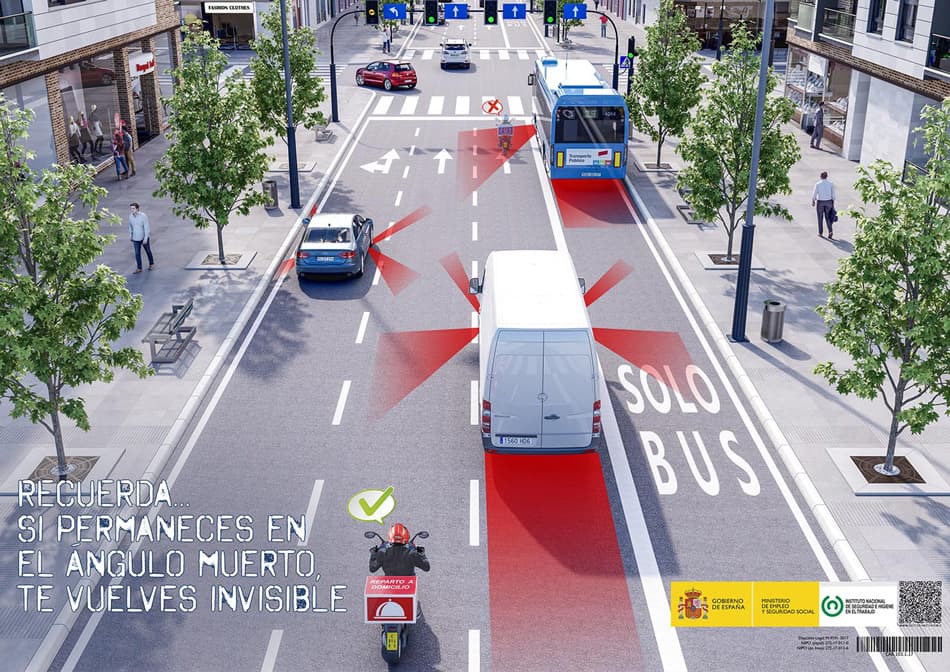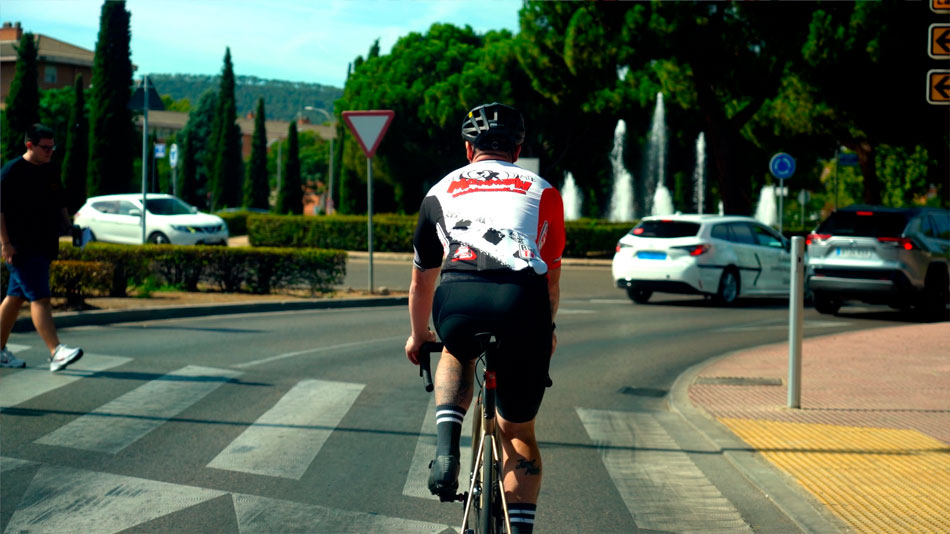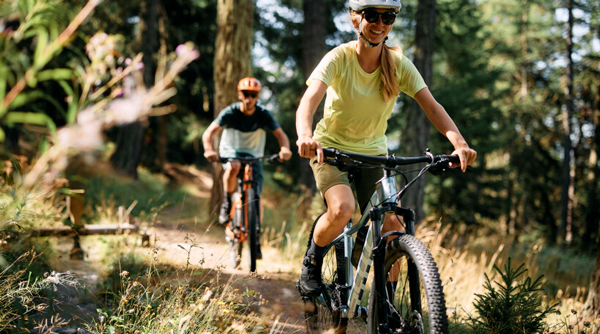There are many benefits to using a bicycle for urban commuting or recreational use, but having to co-exist with other vehicles on the road, involves a risk of accidents. Here, we take a look at the most frequent accidents and give tips on how to avoid them.
The numerous benefits of cycling affect all aspects of our lives, both on a personal, social and environmental level, as it is a non-polluting, economical, healthy and even faster means of transport in city centres. But until the integration of bicycles in traffic is resolved, accidents will continue to be a risk. To minimize this risk, it is important to be aware of the most frequent cycling accidents, to understand why they occur and how they can be avoided. At the end, we will also see what to do if you have a cycling accident.
What is the Most Frequent Type of Cycling Accident?
The most common cause of cycling accidents are impact and collision with motor vehicles, and impact against an open car door is also very frequent. We will first analyse how these accidents occur and then look at how to avoid them.
1. Motorist Turning across Path of Cyclist
This is the most common type of accident involving cyclists. The accident occurs when the vehicle turns at a junction, crossing the path of the cyclist or bicycle lane, where the cyclist has priority. This cyclist is usually riding next to the vehicle, on the left, and the driver turns without noticing the cyclist's presence, either because the rider is in a blind spot or because the driver turns without due precaution or is unfamiliar with the road in question. Large vehicles, such as trucks or buses, are those with the greatest blind spots and, due to their size and turning radius, the cyclist can be caught, in spite of stopping.
2. Side Impact at Junctions
A side collision occurs when a vehicles pulls out of a side road or junction, into the path of the cyclist, without respecting the cyclist’s right-of-way, this even occurs at traffic lights. Most often it is due to lack of visibility, carelessness of the driver or reckless behaviour of one of the two. As cyclists are the most vulnerable party, it is essential to take extreme precautions, as we will see in the section on safety measures.
3. Accidents at Roundabouts
Roundabouts deserve a section of their own, due to their high number of cycling accidents, which are usually of the types mentioned above. Side impact usually occurs when a vehicle enters the roundabout without noticing the presence of the cyclist, and crossing over the cyclist’s path occurs when a vehicle leaves the roundabout without respecting the path of the bicycle.
4. Side Impact when Overtaking
Another very frequent type of cycling accident occurs both in the city and on rural roads, usually due to vehicles not respecting the minimum distance of 1.5 meters when overtaking a cyclist. If the minimum distance is not respected, a pothole, a gust of wind or any other circumstance that modifies the cyclist's path, can cause impact. Even without touching the cyclist, the turbulence of the vehicle can cause the cyclist to fall.
5. Impact against an Open Car Door
This bicycle accident occurs when a driver or passenger opens the door of the vehicle without first checking for oncoming cyclists. It can also occur with cars parked next to bike lanes, causing impact with the cyclist riding in the lane. When this type of negligence occurs, it is difficult to foresee the accident, but we will see how to minimize the risks.
6. Rear-end Collision
Rear-end collision in the same direction of travel is the most frequent accident suffered by cyclists on A roads and the one with the most lethal consequences. And, strangely enough, it occurs most frequently on straight conventional roads and intersections. It is less frequent on urban roads. The causing factors are usually:
-
Lack of visibility.
-
Excessive speed.
-
Lack of attention or carelessness of the driver.
-
Consumption of alcohol and drugs.
It is one of the main causes of death and serious injury to cyclists, and, although it is impossible to foresee certain external factors, such as the greater or lesser responsibility of drivers, cyclists can always take preventive measures, such as making themselves as visible as possible, as we will see in the section on visibility, and even using modern radars that warn of approaching vehicles and their speed.
7. Bicycle Collisions with Cars
Less frequently than those mentioned so far, but accidents involving a bicycle hitting another vehicle do exist.
This can occur:
-
by running into a parked or stopped car, either due to inattention of the cyclist, or because the car is parked in an inappropriate place.
-
by running into a vehicle when it brakes, due to the cyclist not respecting the recommended safety distance.
Cyclists also have to respect road safety rules and always be attentive. Cyclists can also be fined for causing an accident and suffer the legal consequences of civil and even criminal liability, when responsible.
A clear case of this liability, which fortunately is usually anecdotal and does not have consequences for the physical integrity of people, are accidents involving bicycles on roof racks when passing under a bridge or garage entrance with a height barrier.
Where do Most Cycling Accidents Occur?
On urban roads, especially in large cities, where traffic density and the presence of cyclists is much higher. And, for obvious reasons, where roads are shared or bike lanes are not segregated. However, the most serious cycling accidents, with the highest number of fatalities are concentrated on rural A roads, although the overall percentage of road accidents is much lower. This is why it is essential to be extra cautious.
When do Accidents Involving Cyclists Occur Most Frequently?
There are a number of factors that affect the accident rate from a temporal point of view:
- In summer, there is a considerable increase in the number of cyclists, therefore more accidents occur than in winter.
- On weekends throughout the year, for the same reason, there are more accidents than on weekdays. Particularly on summer weekends and in the early hours of the day, when there is a high number of vehicles returning from parties and evening events.
- On the road, at dawn and dusk, visibility is reduced and it is also easier for accidents to occur due to vehicle collisions.
How to Avoid Cycling Accidents?
Although there will always be a factor of uncertainty due to external agents, as with any other activity, the risk of accidents can be drastically reduced, by following safety measures and advice.
What factors increase danger for cyclists? Those related to visibility, driving habits or non-compliance with regulations. And it is these factors that we are going to highlight.
1. Make Yourself Visible
To avoid accidents, the first thing to do is to be seen by other road users, especially drivers of vehicles. To do this, it is essential to use lights, reflectors and reflective elements correctly. It is also essential to comply with the legal regulations of each country, to equip yourself and the bike with lighting and visibility elements.
In the UK any cycle which is used between sunset and sunrise must be fitted with the following:
-
White front light. This can be steady, flashing, or a mixture.
-
Red rear light. This can be steady, flashing, or a mixture.
-
Red rear reflector, even if you carry a rear light, to maintain visibility at all times.
-
Amber/yellow pedal reflectors, front and rear on each pedal . In the following infographic you have illustrated the elements of greater visibility.
Although it is not mandatory, a reflective garment is recommended. The most recommended garment is the vest, but there are also other alternative reflective elements.
 Visibility for cycling
Visibility for cyclingWe recommend that you use lights for all your bike rides, day and night, and increase your visibility by wearing light coloured clothing and accessories, such as helmets and shoes.
As far as lights are concerned, we go into more detail in this other article, where we explain how to choose cycling lights.
2. Controlling the Environment and Protection
It is also very important to check the traffic around you, to understand the movements of other vehicles. Rear-view mirrors are very useful for city and highway driving. They allow you to manoeuvrer safely and help avoid potentially risky situations with other vehicles. You can also find different types of radars that warn you of approaching vehicles and show their speed, so that you can anticipate the possible risks and take extra precautions, if need be.
 Garmin Varia RTL515 light and radar
Garmin Varia RTL515 light and radarDespite all these precautions, it is also useful to wear protection, in case an accident occurs.
What are the most important injuries among cyclists? Undoubtedly, injuries to the back, neck and head. Therefore, all protective measures for these parts of the body will enhance your safety. The type of protection also depends on the cycling discipline. Body protection used for MTB, is not used for road and urban cycling, for example. But it is fundamental to protect your head with the safest helmets.
3. Respect the Rules
A bicycle is just another vehicle and, for your own safety and in order to be respected by drivers and other road users, cyclists must comply with all traffic regulations, especially regulations for cyclists. Cyclists are also subject to the same limitations, such as driving under the influence of alcohol or drugs or the use of headphones, cell phones or other electronic devices.
4. Choose Bike Lanes
Whenever feasible, try to use bike lanes, especially if they are segregated from the roadway. In reality, however, cycling lanes cannot always be used as they are often impractical, especially for road bikes, or are used by pedestrians, making them unsafe for cycling. If it is not possible to ride in cycling lanes, try to choose streets and roadways with less traffic.
 Segregated bike lane
Segregated bike lane5. Use the Lanes Correctly on Each Type of Road.
On A roads, cyclists have to ride on the hard shoulder, whenever possible. And, if you have to occupy the roadway, always ride as close to the side as possible. You can ride in parallel rows of two cyclists, except when there is no visibility (curves, fog, etc.) or when you seriously hinder traffic. You can also circulate on a dual carriageway, if there is no prohibition sign, but always on the hard shoulder. Bicycles are never allowed to circulate on a motorway.
On urban roads, the regulations are different and the recommendations regarding the use of lanes are different:
-
Ride in the centre of the lane and always in the lane that is furthest to the left. In the city there are usually no hard shoulders to ride on, and it is not mandatory to be on the left side of the lane for various safety reasons:
-
If you move to the left of the lane, you may encourage cars to overtake without keeping the minimum safety distance, because it is physically impossible in most urban lanes.
-
If you ride too close to parked vehicles, you run the risk of running into an open car door or a parked vehicle as it pulls out, which can cause an accident to yourself or to others if you swerve to avoid it.
-
Cycling in the centre of the lane makes you more visible to other vehicles when approaching intersections.
-
You can leave the left lane when there is more than one lane in each direction in the following situations:
-
To turn right.
-
To overtake slower vehicles
-
Avoid riding between two lanes, as this is the most dangerous location for a cyclist. Stay in the centre of one lane until you can safely change to the other.
At roundabouts, ride like the other vehicles, occupying the corresponding lane, by riding in the centre to avoid undue overtaking and to make yourself more visible to traffic entering the roundabout. Be extremely careful, as, this is a black spot for cyclists and causes a high accident rate. We recommend you try to make eye contact with driver about to enter the lane. If they do not make eye contact back, they may not have seen you. And, if it is not clear if a vehicle is slowing down, brake if you have to. It is always better to give up your priority than to be run over.
If you are riding in a group, once the first cyclist enters the roundabout, the entire group has priority over any other vehicle, so the group can be considered a single vehicle, providing they ride together. The first cyclist, of course, has to respect the rules for entering the roundabout.
6. Signal and Ride Predictably.
Avoid zigzagging or using abrupt manoeuvers that may surprise drivers. Give warning of your manoeuvers, by using the hand signals included in the highway code and are internationally recognized. The outstretched arm indicates you are turning or about to ride in that direction. The arm at a right angle, with the hand upwards, indicates a turn in the opposite direction. And the flapping your outstretched arm is used to signal braking.
 Cycling hand signals
Cycling hand signals7. Avoid Blind Spots
There are certain areas that are not visible to drivers, in the rear-view mirrors, especially in the case of large vehicles, such as vans, trucks or buses, where the driver is unable to see the cyclist, so it is important to get out of this spot as quickly as possible. Bear this in mind especially when vehicles are going to turn.
 Blind spots
Blind spots8. Use your Common Sense
In the event of a possible accident, take extreme precautions, including giving up your right of way. As we mentioned with roundabouts, it is always better to give up your right of way than to have an accident.
What to do if you Have a Bicycle Accident?
It is convenient to know how to act in the event of a bicycle accident. If you are the victim, apart from the administrative or criminal responsibilities that fall on the driver, you will be entitled to compensation for the bicycle accident, that will cover injuries and material damages suffered by the bicycle and all the equipment carried at the time of the accident.
After receiving the necessary medical attention, the next step is to file a report and contact your insurance company or a specialized lawyer. If there are serious injuries or, in the worst case, death of the cyclist, the medical services themselves will inform the authorities who will file the report ex officio.
Once the complaint against the driver has been filed, legal proceedings begin, which may lead to an out-of-court settlement with the insurance company or to a trial, where the judge will determine the responsibilities and the amount of compensation, depending on the extent of the injuries and whether there are permanent sequelae. In this process it is always highly recommended to have the advice of specialized lawyers.
If you, the cyclist, are responsible for the accident, you are also obliged to cover compensation and will have to answer for administrative or criminal liability, depending on the damage caused. For this reason, although it is not compulsory, we recommend you take out insurance for your cycling activity, covering your own damages and, above all, civil liability. These benefits are often included with cycling club memberships and offered by a number of insurance companies.
Summary
Be respectful of traffic, but don't be afraid to cycle. By observing these recommendations, you minimize the risk of accidents. Be extremely cautious, never let your guard down and keep your attention on other vehicles at all times. Anticipating their movements or reacting to unforeseen events is your best guarantee of safety.
In our Mammoth stores, you will find the advice of professionals and all the accessories that we have recommended to increase your safety.
More information in related articles and videos:



 Visibility for cycling
Visibility for cycling Garmin Varia RTL515 light and radar
Garmin Varia RTL515 light and radar Segregated bike lane
Segregated bike lane Cycling hand signals
Cycling hand signals Blind spots
Blind spots



Leave a comment
Be the first to comment on this article.